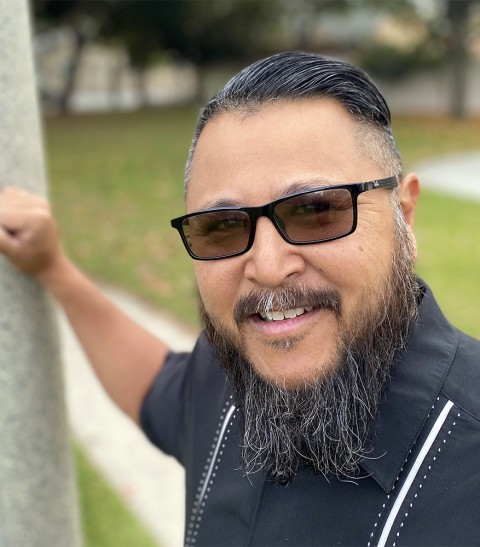Latino Christians grapple with complicated identity

Allen Hernandez wears his Christian faith and his indigenous Maya roots on his sleeves, literally.
His left arm is tattooed with images of the sacred heart of Jesus, a pair of hands clasped in prayer, and an angel praying over the tombstone of a friend.
His right forearm is emblazoned with a tattoo of a feathered serpent, a Mesoamerican deity worshiped by the Yucatán Maya people.
“I am indigenous. I am Mayan and I am Christian,” said Hernandez, 39, whose parents are from Guatemala. “I don’t know how these fit in the same sentence.”
Hernandez, who leads an environmental justice nonprofit in Southern California, often grapples with his identity as a Christian man who cares deeply about the rights of immigrants, LGBTQ people, and working-class communities. He recognizes the perplexity of his tattooed arms because “one’s mission was to kill the other.”
Being a Latino Christian is often a dilemma in a country where the churches are predominantly white or African American. One tradition requires you to adopt the faith of your erstwhile colonizers while the other is built on its own legacy of civil rights and race.
Read our latest issue or browse back issues.
This identity struggle over faith and heritage is what led Robert Chao Romero, a professor of Chicana/o studies and Asian American studies at UCLA, to write his upcoming book, Brown Church. In it, Chao Romero delves into a 500-year history of Latino Christian social justice activism in Latin America and the United States.
While Latinos are not a monolith, they do share a history of colonization and oppression that Chao Romero underscores in his book, which will be released in May.
For Chao Romero, it’s important to highlight this legacy for Latinos—like Hernandez—“who feel in the spiritual borderlands.”
“We care about justice. We care about our communities. We want to devote our lives to those issues, but we also want to capture the fullness of our cultural background. Yes, we have Spanish ancestry, but we also have indigenous ancestry,” he added. “We’re not just going to assimilate.”
As the US continues to experience a decline in Christianity, Chao Romero hopes a “Brown Christian” identity could draw the younger Latino generation into the church.
Americans, including Latinos, are becoming less Christian as the number of people with no religion is rising, a recent Pew Research Center study found.
Marshela Salgado-Solorio, a program director for University Christian Church in San Diego, is familiar with this rise of the nonreligious. Her church, a progressive congregation that welcomes all sexual orientations, skews older. Salgado-Solorio said it’s difficult to bring younger families into the congregation.
She understands why. “I think it’s the same reasons I have such a hard time reconciling my own identity with my friends and with people in the community,” Salgado-Solorio said. “Part of it, it’s stereotypes about the church.”
Salgado-Solorio, 41, grapples not with her faith but with the perceived ideas that others have about her based on her religious upbringing. These preconceived ideas include being conservative, Republican, close-minded, and against immigrants and LGBTQ people, she said.
She was raised in the Church of the Nazarene. Her Guatemalan father worked as a minister in Idaho, where he advocated for the migrant worker community. Her parents were the first nonwhite missionaries from the Church of the Nazarene when they were sent to do work in Switzerland, Salgado-Solorio said. Her father also led a congregation in Chiapas, Mexico. Now back in San Diego, her dad is teaching as an adjunct professor at Point Loma Nazarene University, where he helped start a master of ministry program in Spanish.
Through all of this, Salgado-Solorio saw her father work with interfaith organizations in Latin America and how vocal he became when he felt the church strayed from its social justice roots in helping the poor.
For Salgado-Solorio, just being Latina in the US “you are automatically a part of the oppressed in some way.” That hardship is even more pronounced depending on your gender, sex orientation, or income, she said.
“The churches need to look at history and what’s been done to help be a voice for their own people,” she said. “If we don’t stand up, the Latino churches are going to die out within the next few decades.”
For Hernandez, it’s gotten harder to go to church.
He doesn’t understand how certain Christians can justify the Trump administration’s immigration policies and feel comfortable going to church. Hernandez said it’s hard to grapple with images of immigrant children held in cages.
Hernandez became a Christian in 2000 while he was a student at Azusa Pacific University, a private Christian university in Southern California. Hernandez, who grew up in a working-class home in San Bernardino County, decided to attend Azusa Pacific after he was offered a full-ride scholarship. He had a conversion experience at a university chapel service.
During chapel services, Hernandez said he was often surrounded by white, conservative evangelicals. On his own time, he read the works of Gustavo Gutiérrez—known as the father of liberation theology, a movement focusing on the poor and oppressed. Hernandez also studied James Cone, one of the founders of black liberation theology.
He’s not fully comfortable embracing the Brown Christian identity because it “has oxymoron written all over it.” But he’s not ready to give either part up.
“This might be something that folks like me have to grapple with for the rest of our lives,” Hernandez added. “That’s fine because life is filled with contradictions.” —Religion News Service




